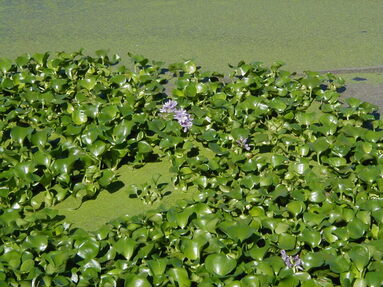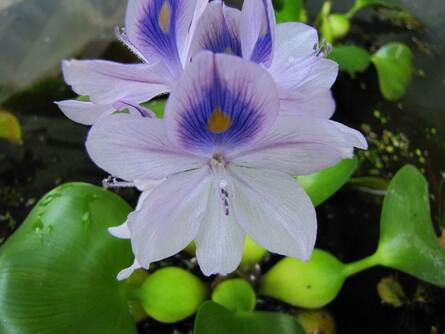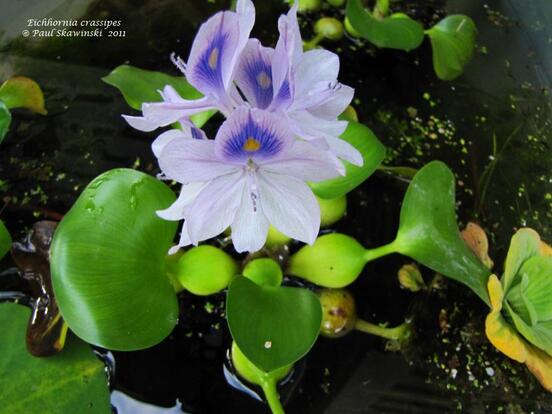|
This is a guest blog post from Melinda Myers Photo credit: Paul Skawinski Water Hyacinth (Eichhornia crassipes) is an aquatic invasive species that can grow quickly, forming dense mats that restrict light to the underwater environment. In February, I asked for your help spreading the word about the impact aquatic invasive plants have on Wisconsin lakes and waterways. Now that summer has arrived and we are spending more time outdoors, you may encounter gardens and natural spaces where these plants are growing. So once again, I am asking for your help.
Start by familiarizing yourself with the more common aquatic invasive plants. For some, this may be a review while others may be surprised to find some beautiful plants are actually problem plants that need to be removed. See Regulated Aquatic Invasive Plants in WI and Common Wetland Invasive Plants in WI for pictures of restricted and prohibited species. The Wisconsin Invasive Species Calendar from the University of Wisconsin Madison First Detector Network is also a helpful tool. It provides a timely reminder of invasive plants to watch for throughout the season based on their life stage and visibility. A new video “Identifying Eight Aquatic Invasive Species in Wisconsin” provides images and identification clues you may find helpful as you enjoy the outdoors and tour gardens. For more detailed information and images of native and invasive aquatic plants see Paul M. Skawinski’s book Aquatic Plants of the Upper Midwest – Fourth Edition. It is available from the Extension Lakes Online Bookstore where you can also find the updated Wisconsin AIS Early Detector Handbook. To learn more about the distribution and control methods for invasive plants you are concerned about contact your regional WI DNR AIS Coordinator found here[JSS1] [JSS2] . If you discover aquatic invasive plant populations in public spaces and waterways, please report them to the Wisconsin Department of Natural Resources (WI DNR) so they can contain and manage the problem. You will find the details for documenting and reporting aquatic invasive species on the WI DNR's Invasive Species Reporting page. Also, watch for invasive plants as you visit and consult with gardeners throughout the summer. When invasive plants are found be sure to make it into a learning opportunity. First assure the gardener that many of us have purchased plants in the past unaware they would eventually become a problem for native plants, wildlife, and beneficial insects. As more gardeners are now purchasing plants online it increases the risk that prohibited and restricted plants find their way into Wisconsin. Add to this the fact that there are many new gardeners that may not be aware this problem exists. Help them understand that how we plant and manage our gardens has an impact on Wisconsin’s natural spaces. Growing even one or two invasive plants in your garden, shoreline planting or pond can have an impact. Invasive plants tend to be vigorous growers, reproducing faster than our native plants, and are more tolerant of adverse conditions. This allows them to quickly spread, take over and cause harm. Advise gardeners on how to dispose of invasive plants properly. Composting is usually not the best option. Most of us do not create compost piles that reach high enough temperatures to kill these weeds, insects, and diseases. To prevent them from invading natural areas it is best to bag and dispose of invasive plants in the trash. The more people you reach with this important message the more gardeners there will be helping in the containment and management of these plants. My AIS partners at UW Madison Extension and the WI DNR AIS remind us that “maintaining and restoring our waters and landscapes can reduce the impacts even when we don’t have other management options for an invasive species. Reporting invasive species is a first step in containing their spread.”
0 Comments
 Photo credit: Wisconsin AIS Partnership Water hyacinths, free-floating aquatic invasive plants, pictured here in Wisconsin waters by Melinda Myers
Spread the word and help make a difference by participating in North America National Invasive Species Awareness Week February 20-26. You have the attention of the garden enthusiasts and homeowners that we need to reach with this message, so we can make a difference in our environment now and in the future. Aquatic invasive species (AIS) impact everyone in our state, whether you enjoy boating, swimming, fishing, hunting, or recreating in or near the many lakes, waterways, and wetlands in Wisconsin. Keeping them free of invasive plants is critical for maintaining our enjoyment and the health of our waterways. With your help, we can spread the word and enlist more people to help. Your audiences come to you with a wide range of experiences and an understanding of this garden-related issue. Explaining the What, Why, and How of invasive species can help them identify ways they can get involved and make a difference. The What: Defining the term invasive plants is always a great place to start the discussion. I think the definition on the North America Invasive Species Awareness Week (NISAW) website is clear. They say “The term "invasive" is used for aggressive species that grow and reproduce rapidly, displace native species, and cause major disturbance to the areas in which they are present.” A key difference that I feel is worth explaining is garden bullies are aggressive plants that stay in the landscape while many invasive plants leave the bounds of our gardens and disturb nearby natural spaces and are regulated under Wisconsin’s Invasive Species Rule NR40. The Why: The Wisconsin Aquatic Invasive Species Management Plan shares the following impacts of AIS: “The introduction of AIS into the Great Lakes and inland state waters is a source of biological pollution that has significant negative effects on natural resources, human health, recreational opportunities, and other ecosystem services throughout the state and region. AIS may compete with native species for food and habitat and can, directly and indirectly, harm or displace native species, degrade habitat, and alter food webs and energy flow. AIS can also have significant economic effects on waterfront property values, tourism, utilities, and other industries.” If aquatic and terrestrial invasive species are not managed, they can and will limit land and water use now and into the future. Our well-cared-for gardens, ponds, and shoreline landscapes can play a role in reducing the wide range of impacts AIS have on individuals, communities, and the state. Your involvement can be at whatever level aligns with their gardening endeavors, abilities, and interest. The How: As gardeners and gardening influencers, we can be part of the solution. Encourage others not to purchase and grow plants restricted in Wisconsin in their water features and landscapes. Although regulations for the sale, purchase, and possession of invasive species are in place, some online sellers are not aware, not up-to-date, or not concerned with following existing state and federal regulations. Just because you are able to purchase a plant does not mean it is allowed in Wisconsin. So it is up to us, the individual gardener, to make sure invasive plants do not end up in our gardens, natural spaces, and waterways. Instead buy plants from a reliable and whenever possible, local source. Learn to identify problem plants and look for alternatives. Encourage gardeners to fill their landscapes and water gardens with native plants. This is an appealing first step in growing success and keeping our waterways safe. I have partnered with the UW-Madison Extension Aquatic Invasive Species Program to help do just that. On February 22 at 6:30 p.m. CT in celebration of NISAW, I am hosting a free webinar, Grow Beautiful Water Gardens Free of Invasive Plants. I will provide tips on identifying problem plants and suitable substitutes. Registration is required; sign up by clicking here. Visit the WI DNR webpage Aquatic Invasive Species and Publications and Products for more helpful tips and resources. Help people properly manage water gardens and landscapes for ease of maintenance and the management of invasive plants. Share the importance of removing and properly disposing of invasive plants to prevent their spread. Most municipalities allow you to bag and throw invasive plants in the garbage. Discourage them from sharing invasive and aggressive plants with friends and family. These well-intentioned “gifts” result in more work for the recipient and can harm nearby natural spaces. For videos to share and help spread the word, click here. Report invasive species populations in public spaces and waterways to the Wisconsin Department of Natural Resources (WI DNR) so they can contain and manage the problem. And if you are interested in volunteering to help control these unwanted plants, email [email protected] to be connected with a county AIS coordinator. The more people watching for these problem plants the sooner we can begin containing and managing the problem. “The longer we ignore the problem the harder and more expensive the battle for control will become,” according to NISAW. Tackling the topic of managing invasive plants can be overwhelming and lead to inaction. My partners at the WI DNR AIS remind us “Maintaining and restoring our waters and landscapes can reduce the impacts even when we don’t have other management options for an invasive species. Reporting invasive species is a first step in containing their spread.” Together we can make a difference! REGISTER FOR THE FREE WEBINAR Feb. 22, 6:30 PM: Grow Beautiful Water Gardens Free of Invasive Plants – Register here. Guest Post by Melinda Myers Spring is a favorite time in the garden. Everyday something new sprouts through the ground, blooms appear, and leaves begin filling empty branches. As you enjoy spring and summer unfolding, keep a lookout for unwelcome plants in gardens, waterways, and natural areas. The more people watching for and helping to manage invasive plants the better chance we have for controlling these invasive plants. As active gardeners and influencers in the gardening world, we need your help not only monitoring and controlling invasive species but also informing others about this problem. The Wisconsin Invasive Species Calendar from the University of Wisconsin-Madison First Detector Network is a helpful tool alerting us to the appearance of various unwanted plants. Just click on the calendar to enlarge. This timely reminder can help us watch for, manage, and report invasive plants earlier in the season. Knowing when these plants emerge also narrows down the list of possible plants, helping with identification. Use this calendar, the links to Invasive Plant factsheets and videos on the right-hand column of the webpage and the invasive plant profiles on the Wisconsin Department of Natural Resources (DNR) website for more information on identification and control of aquatic and terrestrial invasive plants.
As you hike, bike, or visit parks, green spaces, and natural areas this year, report invasive plant infestations to the Wisconsin DNR. If you think you have found a prohibited species, even on your own property, it’s especially important to report it to help DNR understand the overall spread of the plants and they can sometimes help with managing it. Visit their web page for tips on documenting what you have found, reporting invasives, and the links to other resources. Provide photos and specific locations using GPS points, street addresses or road crossings. Expand your efforts and be a part of the Citizen Science based Wisconsin First Detector program. You’ll find helpful information in the Wisconsin First Detector and Dane County Parks Handbook on Monitoring Invasive Plants in Wisconsin. Here are a few of the top aquatic invasive plants to watch for and remove on your property. Please watch for and report infestations of these and other invasive species in your landscape and other spaces. Lesser Celandine This plant’s bright yellow flowers in April and May are often mistaken for our native marsh marigold. The plant spreads rapidly, crowding out nearby native plants but the leaves die back mid-season, resulting in soil erosion. Yellow Iris A beautiful, but invasive plant that easily spreads by seeds floating in water, rhizomes, and floating mats, infesting areas beyond the garden where they were planted. Watch for yellow flowers in May and June and strappy leaves throughout the growing season. Yellow Floating Heart This plant has yellow waterlily-like flowers held above heart-shaped leaves in May through October. This water plant forms dense patches that exclude native species and creates stagnant areas with low oxygen levels. Water Hyacinth Water hyacinth forms a dense mat of leaves over the water surface, making boating, fishing, and other water activities difficult. Its presence also degrades water quality. Watch for circular leaves to begin appearing in May and lavender blue flowers from June to September. Purple Loosestrife This plant seemed to have a banner year in 2021. It invades wetlands, disrupting the habitat and crowding out native plants that birds, insects, and waterfowl depend upon for food and shelter. Many homeowners spraying for mosquitoes may be inadvertently killing the beetles that are being used to manage this plant. Watch for the spikes of purplish pink flowers that open from the bottom up in July through September. Japanese Knotweed Look for the bamboo-like stems and plumes of creamy flowers that appear in September. It quickly spreads, creating an impenetrable thicket in gardens, natural spaces, and shorelines. Water Lettuce As its name implies, this plant resembles lettuce. The leaves appear from June through October and can form a dense covering, degrading water quality and reducing habitat diversity. These plants and other aquatic invasive plants are covered in the Top Invasive Plants to Avoid video. You’ll find recommendations on good plants to include and those to avoid in the “Top Plants for Rain Gardens, Water Gardens & Shoreline Plantings and Those to Avoid” webinar available on demand. To watch it, click here & enter passcode: &xe9hPU^ You can also download the webinar handout. Thanks for helping us spread the word. Together we can make a difference! |
|
| North Country MGV | gARDEN bLOGS |
Location |
|


 RSS Feed
RSS Feed